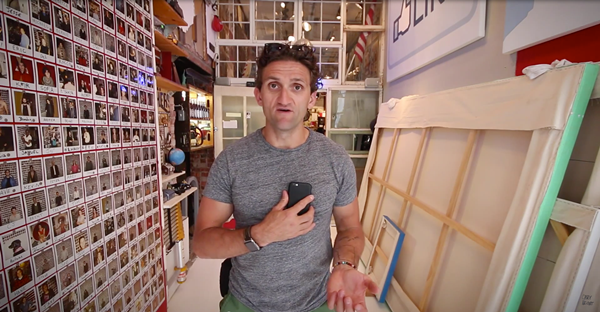Art World
Casey Neistat’s New Video App Asks You to Renounce the Artificial Self-Image
There are no likes, no shares, and no comments.

There are no likes, no shares, and no comments.

Ariana Nakhla

Casey Neistat is a self-made filmmaker known for his daily vlogs on YouTube, to which both his motorized skateboards and uncut candor have garnered him over 900,000 subscribers.
These daily documentations of his life, along with numerous viral videos and an HBO series, are the New York City based filmmaker’s primary platform for creative expression.
Now, Neistat, along with Matt Hackett, the former vice president for engineering at Tumblr, has lent his artistic skill and passion for self-expression to the development of a new social media app designed for capturing and sharing unedited videos.

Called “Beme,” the app is a video messaging service devoid of some of the attributes of other popular film and photo apps like filters and second takes.
You can use Beme by covering the proximity sensor (located above the front microphone) of your iPhone, whether by holding the screen against your chest or covering the sensor with another surface.
Once the sensor is covered, the app will record for four seconds and then automatically upload the short video to be viewed by a user’s followers.
There are no likes, no shares, no comments and user interaction is restricted to “reaction selfies” that can be taken while watching a Beme.
The app’s feed presents users with countless four-second clips labeled by username and location. The videos, which disappear permanently once watched, are not all a collection of mistaken sidewalk shots or disorienting fragments of someone’s day as you might expect. And they’re meant to allow you share a moment with the least amount of technological interference as possible.
“If I’m in the stands at a U2 concert watching Bono,” Neistat told the New York Times, “how can I capture this moment without interrupting it and making it fake?”

In each video, the viewer adopts the perspective of the video’s creator and knows that the raw clip she’s watching was seen in the exact same way by the creator.
And that was Neistat’s intention in creating the app: to provide a completely authentic, universal platform for self-expression that he has found for himself through filmmaking.
With Beme, users do not have to revert their attention from the concert they are watching or the park outing they are enjoying in order to share an experience, nor do they have to worry about finding the right angle or the most flattering light.
With its minimal black and green format, the app is driven by simplicity and authenticity. Users do not have the opportunity to get wrapped up in constructing an artificial self-image or using the app as what Neistat calls a “mirror,” which are evident phenomena on social media platforms such as Instagram, Snapchat, and Facebook.
“Social media has become ‘this is how I want the world to see me,’” Neistat told artnet News in an interview, “whereas Beme is ‘this is how I see the world.’”
Related posts:
New App Allows You to Optimize Art History’s Classic Self-Portraits for the Selfie Age
The Cindy Sherman App: Not Worth 99 Cents
New Study Shows Blue Is Art World’s Most Popular Color